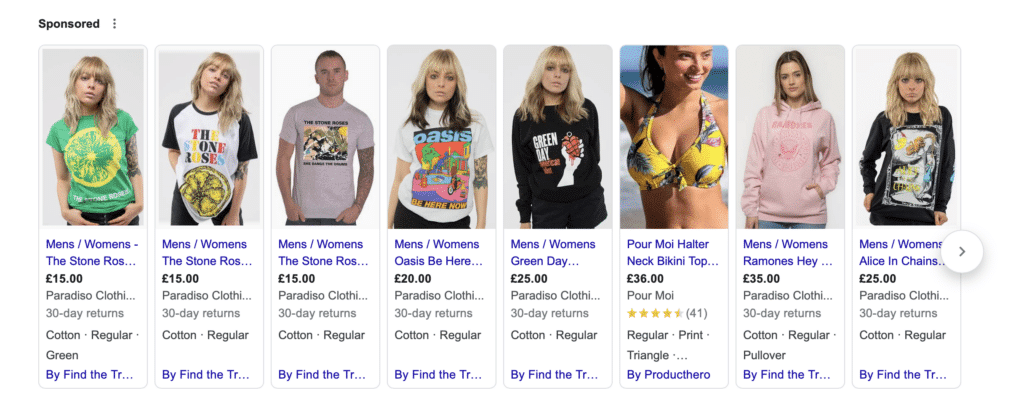How to Get the Best ROI from Shopping Campaigns on Google
 Reading Time: 5 minutes
Reading Time: 5 minutes
In today’s digital age, online advertising has become essential for small businesses looking to reach their target audience. Google Ads, specifically Google Shopping campaigns, can be a powerful tool for increasing brand visibility and driving sales. However, with a limited budget, it’s crucial to understand how to manage your PPC Campaigns and maximise your return on investment (ROI) from Google. In this article, we will explore strategies for small business owners to stretch their budget and get the most out of their Google Ads campaigns, specifically focusing on shopping campaigns.
Table of Contents
Understanding Google Ads and Shopping Campaigns
Google Ads serves as a comprehensive online platform for advertising, presenting an opportunity for businesses to prominently feature their adverts not only on Google’s search engine results but also across a wide network of partner sites. A crucial element within this suite, particularly for e-commerce enterprises, is the shopping campaigns.
These campaigns are designed to showcase products to potential buyers who are in active search mode for specific items. Through shopping campaigns, your products are presented in a more visual and detailed manner, allowing customers to see prices, images, and descriptions directly on the search results page before they even click through to a website.
This immediate visibility significantly enhances the chance of capturing the interest of highly intent-driven customers, making it a vital strategy for e-commerce businesses aiming to directly increase their sales and overall online presence.
Setting Up Your Shopping Campaign for Success
To start a Google Shopping campaign, you must first set up a Google Merchant Centre account. This account acts as the bridge between your product inventory and the vast audience accessible through Google Ads. Upon linking this account to your Google Ads, the subsequent phase involves creating your product feed. This will include adding in essential details of your offerings, ranging from captivating images and competitive pricing to comprehensive descriptions.
It’s imperative that each element of your product feed is optimised with an eye for detail, embedding relevant keywords that potential customers are likely to use in their search queries. Such optimisation not only elevates the visibility of your adverts but also plays a pivotal role in enhancing the likelihood of your products capturing the attention of prospective buyers.
Crafting Compelling Ad Content That Converts
The art of creating advert content that leads to conversions lies in understanding what sets your products apart and communicating this effectively. Your adverts must articulate the unique benefits your products offer, employing language that resonates with your target audience. Incorporate precise, relevant keywords into your copy to enhance visibility in search results, ensuring those keywords align with the intent behind potential customers’ searches. Highlighting any promotional offers or discounts in your advert can significantly increase its appeal, prompting users to take action.

This image is a screenshot from Google’s SERP’s – showing how shopping ads can appear on Google. This Campaign is from an account that we currently work with and do PPC Management for in Liverpool.
Additionally, the selection of images plays a critical role; opt for high-quality visuals that accurately depict your products, fostering trust and interest. This approach not only attracts attention but also encourages clicks, steering potential buyers towards making a purchase. By crafting advert content with these elements in mind, you increase the likelihood of turning viewers into customers, thereby elevating your campaign’s conversion rate.
Monitoring and Adjusting Your Campaigns
The importance of continuous monitoring in Google Ads campaigns cannot be overstated. It provides an essential insight into how your adverts resonate with your audience, highlighting what works and pinpointing areas ripe for optimisation. Keeping an attentive eye on metrics such as the click-through rate (CTR), conversion rate, and return on ad spend (ROAS) allows you to gauge the effectiveness of your strategies in real-time.
This ongoing assessment empowers you to refine your bids, tweak your targeting parameters, and adjust your ad content to bolster your campaign’s performance. For instance, a lower-than-expected CTR might suggest the need to revise your ad copy or imagery to better capture your audience’s attention. Similarly, analysing conversion rates can unveil valuable trends, informing whether your landing page aligns with the expectations set by your adverts.
This proactive approach to campaign management ensures that your advertising efforts are not just a set-and-forget endeavour but a dynamic process that evolves to meet your business objectives and market demands efficiently.
Avoiding Common Pitfalls in Google Ads Shopping Campaigns
Navigating Google Ads Shopping Campaigns effectively necessitates a strategic approach to avoid common traps that can erode your advertising budget. One frequent oversight is the failure to refine product feeds with precision. Ensuring your feed is complete with detailed, accurate product information and high-quality images is pivotal for capturing the interest of potential buyers.
Another trap is the underutilisation of negative keywords, which can help filter out irrelevant traffic and focus your budget on searches with a higher likelihood of conversion. Additionally, overlooking the importance of a mobile-optimised experience can detrimentally affect your campaign’s success, given the increasing propensity for consumers to shop on mobile devices.
It’s also crucial to avoid setting and forgetting your campaigns. The dynamic nature of Google Ads requires regular monitoring and adjustment based on performance metrics to fine-tune your strategy for optimal results. Lastly, an overly broad target audience can dilute your advertising efforts, making it imperative to hone in on your ideal customer demographics and behaviours.
By steering clear of these common missteps and adopting a meticulous, data-driven approach, you can enhance the effectiveness of your Google Ads Shopping Campaigns, ensuring your budget is utilised in the most efficient manner possible.
Conclusion
In summary, utilising Google Ads, particularly through shopping campaigns, presents an invaluable avenue for small businesses aiming to enhance their online presence and sales. By meticulously setting up and managing your campaigns—from optimising your product feeds to crafting compelling ad content and continuously refining your strategies based on performance analytics—you position your business to maximise its advertising ROI.
Remember, the effectiveness of your Google Ads endeavour hinges on a combination of strategic planning, ongoing optimisation, and avoiding common pitfalls that could otherwise compromise your results. With a careful and informed approach, even businesses operating with constrained budgets can unlock the potential of Google Ads to achieve significant, measurable returns.

